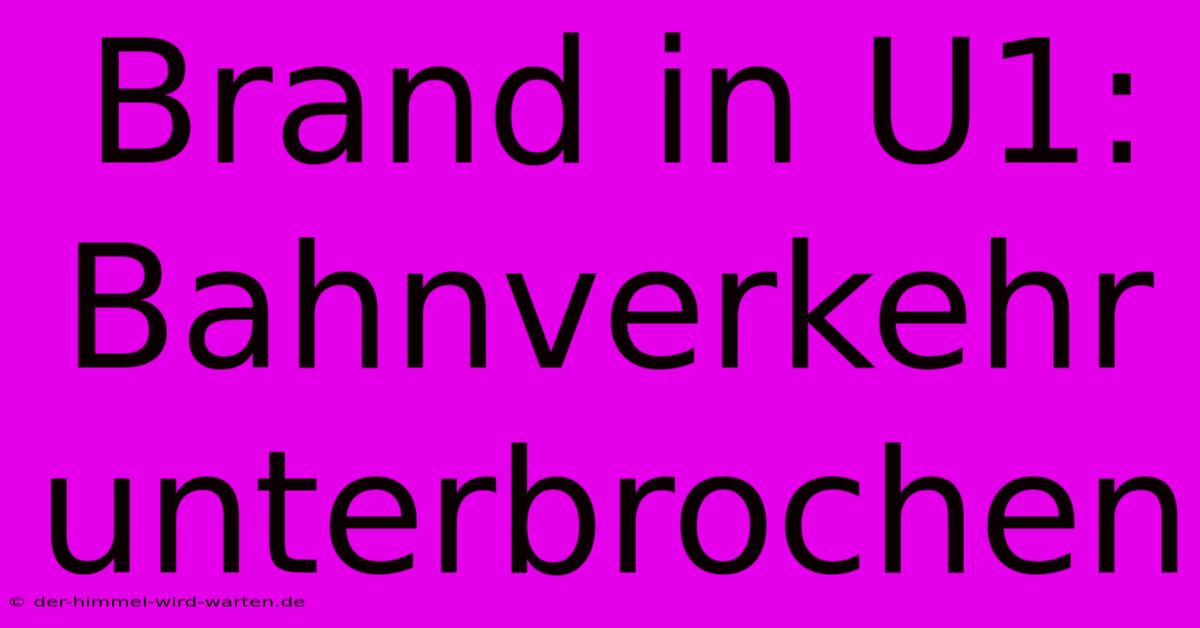Brand In U1: Bahnverkehr Unterbrochen

Discover more detailed and exciting information on our website. Click the link below to start your adventure: Visit Best Website Brand In U1: Bahnverkehr Unterbrochen. Don't miss out!
Table of Contents
Brand in U1: Bahnverkehr unterbrochen – Chaos in der City!
Okay, folks, let's talk about that time – the U1 fire. Total chaos, right? I mean, who expected that? I was stuck downtown, near the Wittenbergplatz station, when the announcements started blaring about a fire on the U1 line. My first thought? "Ugh, another delay?" Little did I know... this was way beyond a typical S-Bahn Verspätung.
The Initial Panic and the Information Void
The station went crazy. People were shouting, pushing, checking their phones – the usual frantic scene when public transport goes south. Information was… sparse, to say the least. The announcements were repetitive and unhelpful. I tried the BVG app, naturally, but it was lagging like crazy. Seriously, the app crashed three times! I even tried the BVG website, but it was equally unhelpful. It's like they weren't prepared for this level of disruption. This lack of real-time information just added to the overall stress.
Lesson learned: If you're a transit authority (or any business, really!), reliable, real-time information is crucial during a crisis. It minimizes panic and keeps people informed. Think clear, concise messages on multiple channels – apps, websites, social media – all updated frequently.
Navigating the Alternative Routes: A Real-Life Adventure
So, there I was, stranded. My plans went out the window faster than you can say "Brandgefahr!" I tried to find alternative routes using the BVG app (after it finally decided to cooperate), but it was suggesting routes that would've added at least an hour to my journey. I ended up resorting to good old Google Maps, which, surprisingly, gave me a quicker, albeit slightly more convoluted, walking route. It wasn't ideal, but hey, I got there eventually.
Pro-tip: Always have a backup plan when using public transit, especially in a major city like Berlin. Familiarize yourself with alternative routes and transportation options. Download offline maps – seriously, this is essential. And, learn how to use Google Maps effectively in your city for optimal routing and alternative transportation options during disruptions.
The Aftermath: Lessons Learned (and a Little Bit of Frustration)
The whole experience was… frustrating, to say the least. The disruption to my schedule was annoying, but the lack of clear communication was infuriating. It made me think about how important clear, concise information is during an emergency.
For me, what was particularly frustrating was the lack of consistently updated info. What I needed was accurate details about the extent of the damage, estimated time of service resumption, and alternative routes. The delay in communication and lack of clear information made an already chaotic situation far worse.
Key takeaway: Businesses, especially those in the public sector, need to invest in robust communication systems. Real-time updates, multiple communication channels, and clear, concise messaging are non-negotiable. Think about how you can improve your communication during unexpected events – it could save the day (or at least minimize the chaos). This applies not just to the BVG, but to any business that deals with the public and experiences unexpected disruptions.
This U1 fire taught me a valuable lesson about the importance of emergency preparedness, both personally and for organizations. It also highlighted the critical role of clear and consistent communication in crisis situations. And I definitely added offline maps to my smartphone. Never again!

Thank you for visiting our website wich cover about Brand In U1: Bahnverkehr Unterbrochen. We hope the information provided has been useful to you. Feel free to contact us if you have any questions or need further assistance. See you next time and dont miss to bookmark.
Featured Posts
-
Trauer Um Liam Payne Kate Und Damian Hurley Gemeinsam
Nov 20, 2024
-
4 Gamechangers Abgesagt Pro Sieben And Orf
Nov 20, 2024
-
Dubai Schoko Hype Server Kollabiert Nichts Mehr Da
Nov 20, 2024
-
Schneefall Im Flachland Wahrscheinlich
Nov 20, 2024
-
Grippeimpfung Besserer Herzschutz
Nov 20, 2024
